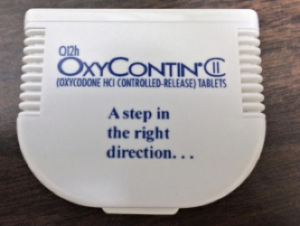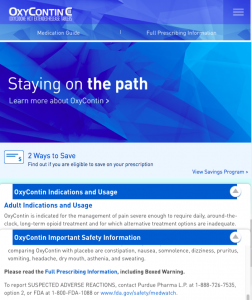When flipping through TV channels, you are likely to encounter at least a few commercials advertising for pain killers. These commercials often urge you to contact your physician in order to get a prescription for it. While we have all seen these commercials, we tend to ignore the most important part: the side effects. While the commercial spends 90% of it’s air time advertising how the medicine could potentially help you, it spends little time warning you of side effects such as “constipation, dizziness, liver damage, nausea and vomiting, dependence” these are just a few of the common side effects listed on WebMD (WebMD). Although you do hear about these prescription medicines being advertised, you don’t usually hear about opioid prescriptions being advertised. This is because most physicians will not prescribe you of a strong pain killer if you just go in and ask. You must have present symptoms or a recurring injury for some.
One of the opioids that has hit close to home for me is OxyContin. Upon going to the OxyContin brand website, you must choose whether you are a healthcare professional or a patient or caregiver. After clicking on “patient or caregiver” it will take you to a new website that has two informative text boxes at the bottom of the page (pictured below). OxyContin is a form of medication that is produced by Purdue Pharma, this company has been around since 1892 on a corporate level and on a production level since 1955. It is “a privately help pharmaceutical company founded by physicians,” and their mission is as follows: “to find, develop, and introduce innovative medicines that meet the evolving needs of healthcare professionals, patients and caregivers” (Purdue Pharma). It was in 1972 that they developed Contin and in 1996 they launched OxyContin, and in 2013 OxyContin was approved new labeling of Full Prescribing Information. To learn more about their company ethics, head over to their Ethics & Compliance page, http://www.purduepharma.com/about/ethics-compliance/.
Unfortunately, there are not many advertisements out for opioid drugs as these tend to be classified as schedule II narcotics. Being a schedule II substance means that they have a high potential for abuse and could lead to physiological or mental health problems. In the one ad I did find, it referred to OxyContin as “A step in the right direction…” (pictured below). This is a direct advertisement to the consumer, reminding them every time they take their pill that it will ensure you are getting better because you are not feeling as much pain. This form of advertisement is a subtle trick that some pharmaceutical companies use. It puts a subconscious reminder in your brain that this is helping you be a better part of today’s society and by making you believe that, it encourages you to continue to take the drug. This is a direct advertisement to the consumer as it ends up in their house.

OxyContin has one main active ingredient, which is oxycodone. This means that OxyContin and oxycodone are truly the same drug, but OxyContin is a stronger version of it. Oxycodone is an extremely powerful pain reliever, which means that misuse of this drug can lead to “addiction, poisoning, overdose, or even death” (Illinois-Chicago, U.O.). After reading more into how oxycodone works, I found that it “changes the way that the brain responds to pain…(and) has a high potential for abuse…(and) may lead to severe psychological or physical dependence” (The Effects of Oxycodone Use). As a result of this high risk for abuse, there is subsequently a high risk for overdose making this a rather dangerous drug. Some of the negative long-term effects include kidney and liver failure and can lead to harder times taking in new information and retaining it. It could lead to both a psychological dependency or a physical dependency, which booth affect the way people feel. Psychologically, it creates a sort of euphoric and blissful feeling that people don’t want to let go of; physically, tolerance is likely to develop very quickly while taking oxycodone. While there is a possible positive side effect, helping manage pain, there are far more negative side effects to be aware of (The Effects of Oxycodone Use).
Overall, I feel like this drug has a high potential of going bad and I have been on the receiving end of this. I tore my ACL and had to have surgery to have it repaired. I remember taking OxyContin as my long-term painkiller and developing an addiction to it. It began with basic side effects of taking new medication such as dizziness, drowsiness and an overall high feeling. However, as the first day went on I did not eat and felt extremely nauseous. I was up all night long, half the time sitting over the toilet or with a bowl by my bed just in case I couldn’t hold down the pill. After my body adjusted, the painkiller really helped with the pain. I was alternating the OxyContin and ibuprofen as prescribed and things were looking up. We started to reduce my doses and that’s when the problems began again. I began to feel agitated, emotional and had extremely bad cramps. We were able to push past the first few problems and then came the first day back to school. I had to wait an extra 30-minutes to take my dose because I was supposed to drive myself to school that day or else I would have been stuck on campus after school and I wanted to see how long I could go without the painkiller. Unfortunately, I wasn’t even able to make it out of the house initially. I was stuck sitting on the couch with my sister crying for honestly no reason. I remember the conversation with my sister as she reminded me that I didn’t have to go back to school if I wasn’t ready. She had gone through a similar experience when she tore her rotator cuff and was taking Vicodin, the side effects and addiction of that for her was so strong that they had to switch her to a different painkiller, one that was less strong and less addictive. I responded to her through the tears, “I want to go though, I don’t know why I’m so upset.” This was one of the most frustrating things for me as I don’t cry often and am very strong and capable. Being held back by something out of my control was honestly worse than the pain and that is something I would not wish on anyone. The fact of the matter is that, at least temporarily, OxyContin changed the way my brain functioned. It not only changed the way that I reacted to pain, but it changed my ability to control my psychological state which was extremely detrimental to my mental health.
Painkillers are not something to mess around with, as our 44th president Barack Obama stated, “more Americans now die every year from drug overdoses than they do from motor vehicle crashes the majority of those overdoses involve legal prescription drugs.” This alone should be able to show you how dangerous opioids are, as most prescription painkillers fall under opioids. In the last 25 years, “the number of prescriptions for opioids have escalated from around 76 million in 1991 to nearly 207 million in 2013” (Abuse, N.I.) this results in the U.S. the biggest consumer of painkillers. The rising number or prescriptions also means there is a rising number of addictions and overdoses, which is probably what prompted President Obama to make such a comment as the one above. On top of the rising number of painkiller prescriptions, there is also a direct correlation to an increase of heroin abusers, as it is usually cheaper than the addicts pill of choice. Within a 7 year-span, “the number of heroin users in the United States doubled, going from 380,000 to 670,000” (Abuse, N.I.).
Going off of my own experiences, I wouldn’t recommend this drug to anyone with addiction in the family as it is too easily obtainable post-prescription and it is extremely easy to develop dependency to it. Leaning away from my personal experience, I would possibly recommend it as it is a very useful painkiller that is trusted by many, many physicians. I would only recommend it to family and friends post surgery or post traumatic injury. I also think that it is extremely important to share patient-family health when it comes to addiction with your doctor when they are going to prescribe you such pills. It is also important to stay in contact for the first few days after beginning to take opioids of any kind, as there are often early warning signs of addiction and side effects. Take the time to educate yourself and the people around you before you start so that everyone knows what to be looking out for in case something goes wrong because it can be hard to tell or even to admit it if it is happening to you.
Opioid (Narcotic) Pain Medications. (n.d.). Retrieved October 25, 2017, from https://www.webmd.com/pain-management/guide/narcotic-pain-medications
About Purdue. (n.d.). Retrieved October 25, 2017, from http://www.purduepharma.com/about/
Illinois-Chicago, U. O. (2016, May 23). Oxycodone vs. OxyContin. Retrieved October 25, 2017, from https://www.healthline.com/health/pain-relief/oxycodone-vs-oxycontin#with-other-conditions8
The Effects of Oxycodone Use. (2017, May 25). Retrieved October 25, 2017, from https://drugabuse.com/library/the-effects-of-oxycodone-use/
Abuse, N. I. (2014, May 14). America’s Addiction to Opioids: Heroin and Prescription Drug Abuse. Retrieved October 25, 2017, from https://www.drugabuse.gov/about-nida/legislative-activities/testimony-to-congress/2016/americas-addiction-to-opioids-heroin-prescription-drug-abuse
